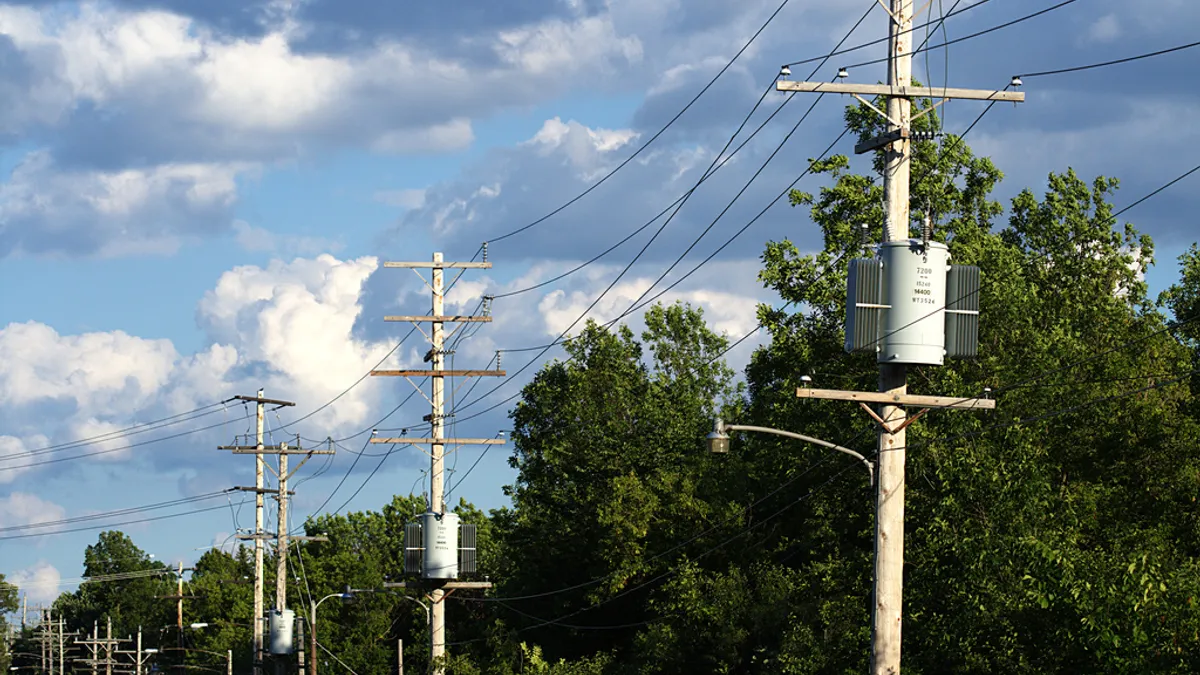Editor’s Note: This story has been updated to include comments from a U.S. Department of Energy spokesperson.
Dive Brief:
- Utilities and efficiency advocates have staked out opposing positions ahead of a Thursday meeting with the U.S. Department of Energy to discuss proposed efficiency standards for distribution transformers – a vital piece of equipment the power sector is struggling to keep in sufficient numbers amid supply chain constraints.
- “This rule would impose unnecessary cost burdens and further delay the delivery of such critical products,” a broad coalition of electric companies and other stakeholders wrote in a Wednesday letter to DOE.
- But today’s transformers rely on “outdated technology” that wastes substantial electricity, said Andrew deLaski, executive director of the Appliance Standards Awareness Project. More efficient transformers require a new type of steel, and the nation’s only mill capable of producing the transformer cores says it can quickly ramp up production.
Dive Insight:
DOE proposed new energy-efficiency standards for distribution transformers in December, and today will host a discussion of the possible changes with stakeholders. In recent days, utility groups have filed comments with the DOE and the U.S. Department of Justice sounding alarm.
The changes “could significantly impact national security and grid reliability,” a group of utilities and other stakeholders wrote DOE on Wednesday. The group includes: the American Public Power Association, Edison Electric Institute, GridWise Alliance, Leading Builders of America, National Association of Home Builders, National Electrical Manufacturers Association and the National Rural Electric Cooperative Association.
“The proposed rule would require manufacturers to transition to a different type of steel, which is largely untested, less flexible, and more expensive,” the coalition warned.
NRECA and APPA separately sent a letter to DOJ on Feb. 10 warning the proposal “risks putting the domestic electrical steel market in a precarious state.”
DOE’s proposal would impact three categories of distribution transformers, requiring them to include amorphous steel cores that are more efficient than those typically made of grain-oriented electrical steel. The rule would come into effect in 2027, aiming to reduce greenhouse gas emissions and potentially saving consumers approximately $15 billion over 30 years.
“Most distribution transformers today use outdated technology that wastes electricity before it even gets to our homes and businesses,” deLaski said in a statement. The new standard “would ensure all new models minimize waste and use materials with a robust long-term supply, making electricity supply both more affordable and more reliable.”
Opponents of the new rules say they worry about the availability of the new transformers, as well as their cost.
“We have serious concerns about whether the only domestic producer of amorphous steel cores today would even be able to meet electric utilities’ demand for distribution transformers,” the utility coalition told DOE.
That producer — South Carolina-based Metglas — says it can handle the demand because the production process for amorphous steel cores is simpler and easier to scale than it is for grain-oriented electrical steel cores. The company also says the lifetime cost of its transformer is lower than traditional transformers, while initial costs are becoming more competitive as well.
“The speed with which we can install additional capacity is very, very quick compared to anything else that that we compete with,” said Metglas President and Chief Operating Officer Rob Reed in an interview. “We have developed techniques that would allow us to expand in a modular fashion to meet the market as it grows.”
Metglas has a “single-digit” share of the domestic distribution transformer market, said Reed, but could quickly scale to more than 20%. The company has sold its transformer cores in China, India and Canada.
“The perception that the market will convert 100% to amorphous, we don't think that necessarily has to happen,” Reed said. “Of course, that's our product so we would enjoy any growth. But there's absolutely cases where [grain-oriented electrical steel transformers] still would be very competitive.”
A Department of Energy spokesperson said the agency is working with the power sector to “identify the underlying factors leading to this supply-demand imbalance for distribution transformers.”
“This includes engaging utilities and manufacturers of distribution transformers and raw electrical grade steel to better cross collaborate to find existing resources and identify new solutions in the private and public sector to help alleviate the supply constraints,” the spokesperson said. “Separately, the proposed rule is looking at the efficiency improvements that can be employed in distribution transformers in the future.”















